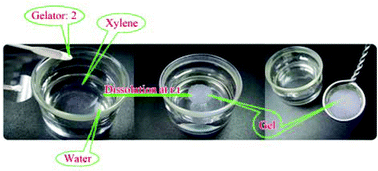Four new diacid amides of dicholesteryl L-phenylalaninate were designed and prepared. The compounds with spacers containing three, four, five, or six carbon atoms are denoted as 1–4, respectively. Gelation tests showed that the four compounds are versatile organogelators, and a subtle change in the length of the spacer can produce a dramatic change in the gelation behaviors of the compounds, as well as the micro-structures of the gel networks as revealed by SEM and XRD measurements. Within the 77 gel systems studied, at least seven of them, including 2/kerosene, 2/toluene, 2/xylene, 3/kerosene, 3/1-pentanol, 3/1-hexanol and 3/1-heptanol, gel spontaneously at room temperature. Furthermore, 2 and 3 can be used for the selective gelation of xylene or kerosene from their mixtures with water. Importantly, heating and cooling cycle or addition of a co-solvent is not necessary for the selective gelation. Furthermore, the gels of 2/xylene are mechanically strong enough for separation, and thereby it is believed that 2 is a strong candidate for the practical separation of xylene from its mixture with water. FT-IR and temperature-dependent 1H NMR measurements demonstrated that inter-molecular hydrogen bonding plays an important role for the formation and maintenance of the gel networks.


 Please wait while we load your content...
Please wait while we load your content...